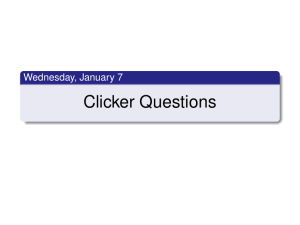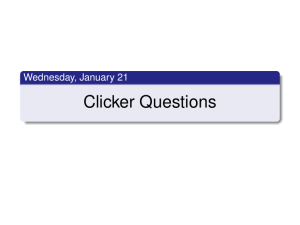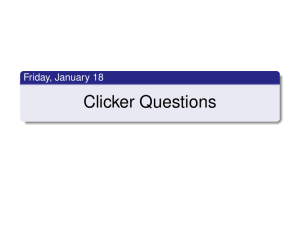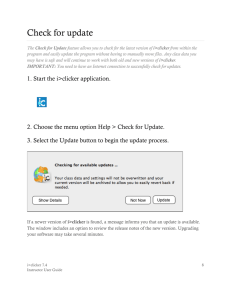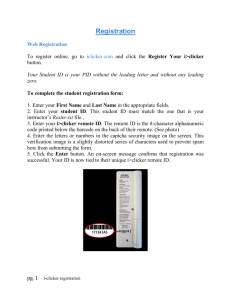T i p s
advertisement
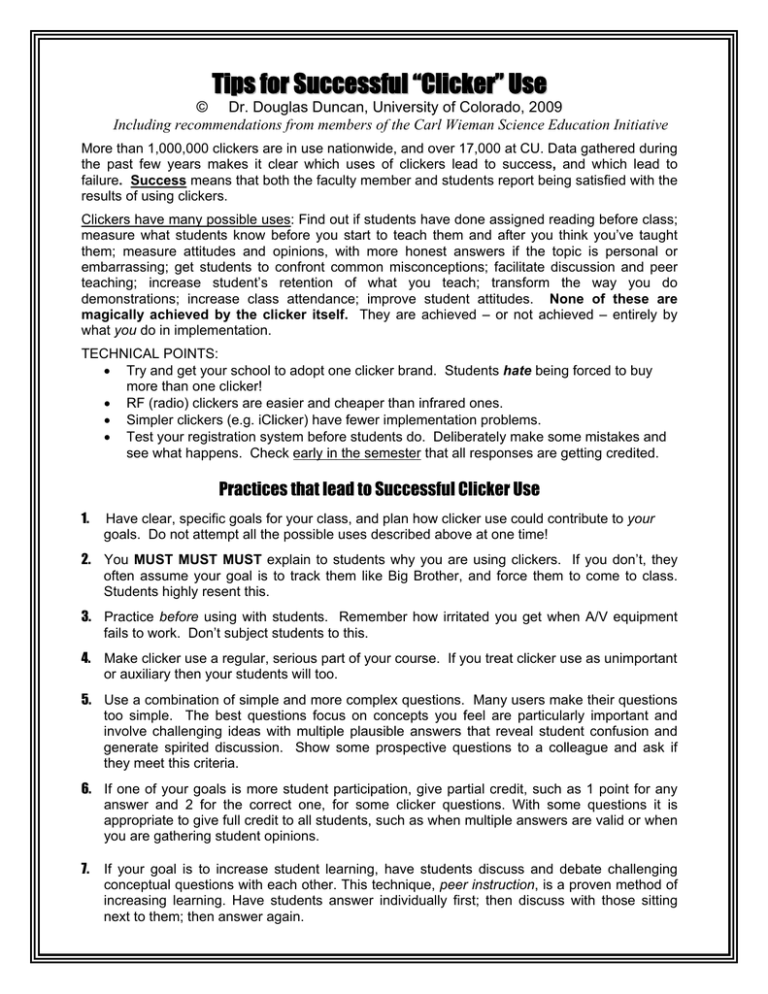
Tips for Successful “Clicker” Use © Dr. Douglas Duncan, University of Colorado, 2009 Including recommendations from members of the Carl Wieman Science Education Initiative More than 1,000,000 clickers are in use nationwide, and over 17,000 at CU. Data gathered during the past few years makes it clear which uses of clickers lead to success, and which lead to failure. Success means that both the faculty member and students report being satisfied with the results of using clickers. Clickers have many possible uses: Find out if students have done assigned reading before class; measure what students know before you start to teach them and after you think you’ve taught them; measure attitudes and opinions, with more honest answers if the topic is personal or embarrassing; get students to confront common misconceptions; facilitate discussion and peer teaching; increase student’s retention of what you teach; transform the way you do demonstrations; increase class attendance; improve student attitudes. None of these are magically achieved by the clicker itself. They are achieved – or not achieved – entirely by what you do in implementation. TECHNICAL POINTS: • Try and get your school to adopt one clicker brand. Students hate being forced to buy more than one clicker! • RF (radio) clickers are easier and cheaper than infrared ones. • Simpler clickers (e.g. iClicker) have fewer implementation problems. • Test your registration system before students do. Deliberately make some mistakes and see what happens. Check early in the semester that all responses are getting credited. Practices that lead to Successful Clicker Use 1. Have clear, specific goals for your class, and plan how clicker use could contribute to your goals. Do not attempt all the possible uses described above at one time! 2. You MUST MUST MUST explain to students why you are using clickers. If you don’t, they often assume your goal is to track them like Big Brother, and force them to come to class. Students highly resent this. 3. Practice before using with students. Remember how irritated you get when A/V equipment fails to work. Don’t subject students to this. 4. Make clicker use a regular, serious part of your course. If you treat clicker use as unimportant or auxiliary then your students will too. 5. Use a combination of simple and more complex questions. Many users make their questions too simple. The best questions focus on concepts you feel are particularly important and involve challenging ideas with multiple plausible answers that reveal student confusion and generate spirited discussion. Show some prospective questions to a colleague and ask if they meet this criteria. 6. If one of your goals is more student participation, give partial credit, such as 1 point for any answer and 2 for the correct one, for some clicker questions. With some questions it is appropriate to give full credit to all students, such as when multiple answers are valid or when you are gathering student opinions. 7. If your goal is to increase student learning, have students discuss and debate challenging conceptual questions with each other. This technique, peer instruction, is a proven method of increasing learning. Have students answer individually first; then discuss with those sitting next to them; then answer again. 8. Stress that genuine learning is not easy and that conceptual questions and conversations with peers can help students find out what they don’t really understand and need to think about further, as well as help you pace the class. Students tend to focus on correct answers, not learning. Explain that it is the discussion itself that produces learning and if they “click in” without participating they will probably get a lower grade on exams than the students who are more active in discussion. My students came up with the phrase, “No brain, no gain.” 9. Use the time that students are discussing clicker questions to circulate and listen to their reasoning. This is very valuable and often surprising. After students vote be sure to discuss wrong answers and why they are wrong, not just why a right answer is correct. 10. Compile a sufficient number of good clicker questions and exchange them with other faculty. The best questions for peer discussion are ones that around 30-70% of students can answer correctly before discussion with peers. This maximizes good discussion and learning. There is value in discussion even if a question is difficult and few know the answer initially. 11. If you are a first-time clicker user, start with just one or two questions per class. Increase your use as you become more comfortable. 12. Explain what you will do when a student’s clicker doesn’t work, or if a student forgets to bring it to class. You can deal with that problem as well as personal problems that cause students to miss class by dropping 5-10 of the lowest clicker scores for each student. 13. Talk directly about cheating. Emphasize that using a clicker for someone else is like taking an exam for someone else and is cause for discipline. Explain what the discipline would be. 14. Watching one class or even part of a class taught by an experienced clicker user is a good way to rapidly improve your clicker use. Practices that lead to Failure 1. Fail to explain why you are using clickers. 2. Use them primarily for attendance. 3. Don’t have students talk with each other. 4. Use only factual recall questions. 5. Don’t make use of the student response information. 6. Fail to discuss what learning means or the depth of participation and learning you expect in your class. 7. Think of clickers as a testing device, rather than a device to inform learning. If you believe that the teacher, not the students, should be the focus of the classroom experience, it is unlikely that clickers will work well for you. Be prepared . . . Effective clicker use with peer discussions results in a livelier and more interesting class, for you as well as the students! Expect good results immediately but better results as you become more experienced with clickers. This is the usual experience nationwide. Further information and references will be put in http://casa.colorado.edu/~dduncan/clickers . I’d like to hear about your experiences, good and bad, and perhaps include them in future editions of my book on how to teach with clickers. dduncan@colorado.edu.
